August 16, 2007
Musée d'Orsay and Sainte-Chapelle
On Wednesday we went to the Musée d'Orsay (Orsay Museum). It is best known for its collection of impressionist works. We were able to get children's activity pamphlets from the information desk. The pamphlets had things for the kids to do, like look for certain works of art, draw shapes found in the architecture, complete a maze, etc.
Brooke had decided at the Marmottan Museum that she likes Monet's Japanese bridge series. She found one in the Orsay to pose in front of.
Tiffany liked the juxtaposition of these two paintings of Monet's wife Camilla.
The Musée d'Orsay is located in what used to be a train station. One of the activities in the children's pamphlet was to look for the parts of the building that are still the same as when it was a train station.
It took a long time to get home from the museum because the area around Notre Dame was shut down due to a Catholic holiday. When we arrived home we walked around Notre Dame to see if anything was going on. There had been a procession in the streets around Notre Dame while we were at the museum, so we missed it.
On Thursday morning we went to Sainte-Chapelle. It is less than a block from our apartment. Whenever we passed the entrance we had seen long lines, so we went pretty early in the morning.
Sainte-Chapelle is in the middle of the Palais de Justice complex. The Palais de Justice contains the highest courts in France. Part of the reason the lines are long is due to the security screening necessary to enter the complex.
We happened to enter the church just as a guided tour was starting. It was in French, but Scott listened and was able to explain it to the rest of the family. We learned many things about the history of the church and its famous stained glass. For example, the reason it is a sainte chapelle instead of just a chapelle is because it was built to house holy relics such as pieces of the cross and thorns from the crown of thorns.
There are large stained glass panels that go almost all the way around the building. They tell stories from the Bible. We learned that you "read" the stories by starting in the lower left corner of a set of four windows and read left-to-right and then work your way up. This is the last set of windows and tells the story of how the holy relics were found for the Sainte-Chapelle. It cost Louis IX three times more to purchase the relics than it cost to build the church.
This rose window dates from the 15th century and not the 13th century like the rest of the stained glass windows. One way you can tell is that the colors are different. In the two centuries between them a lot of technology was learned about how to make better colors of glass. The color red is more vibrant and there are more variations in color.
Brooke is pointing to a carving of a castle. The castle and fleur-de-lis symbols were a recurring theme throughout the architecture and decoration of the church in honor of King Louis.
After some lunch, we went to visit the shopping complex in the Louvre and to plan out our visit to the Louvre the next week. Brooke and Tyler especially liked this small pyramid. You may recognize it from the movie The Da Vinci Code.
On our walk home, we stopped on this bridge to watch a boat pass underneath on its way down the Seine.
Posted by sjbowden at August 16, 2007 10:22 PM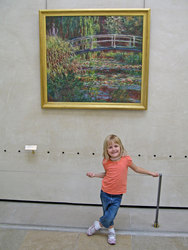 Japanese bridge
Japanese bridge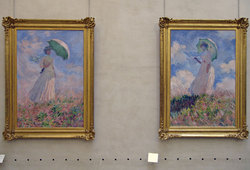 More Monet paintings
More Monet paintings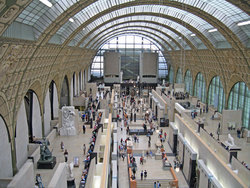 Musee d'Orsay
Musee d'Orsay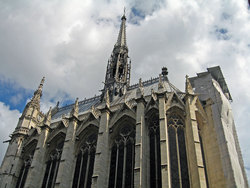 Sainte-Chapelle
Sainte-Chapelle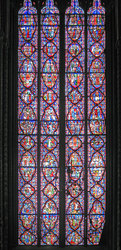 Sainte-Chapelle panel window
Sainte-Chapelle panel window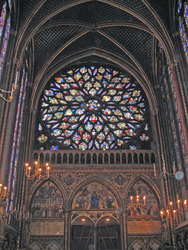 Sainte-Chapelle Rose window
Sainte-Chapelle Rose window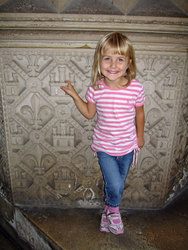 Sainte-Chapelle carvings
Sainte-Chapelle carvings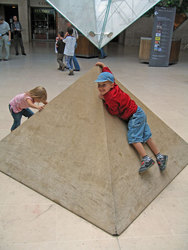 Climbing the pyramid
Climbing the pyramid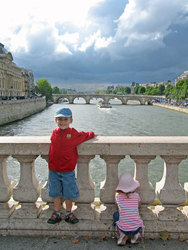 The Seine
The Seine